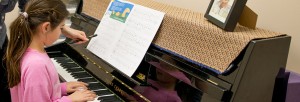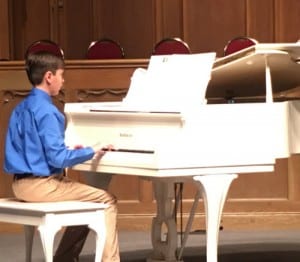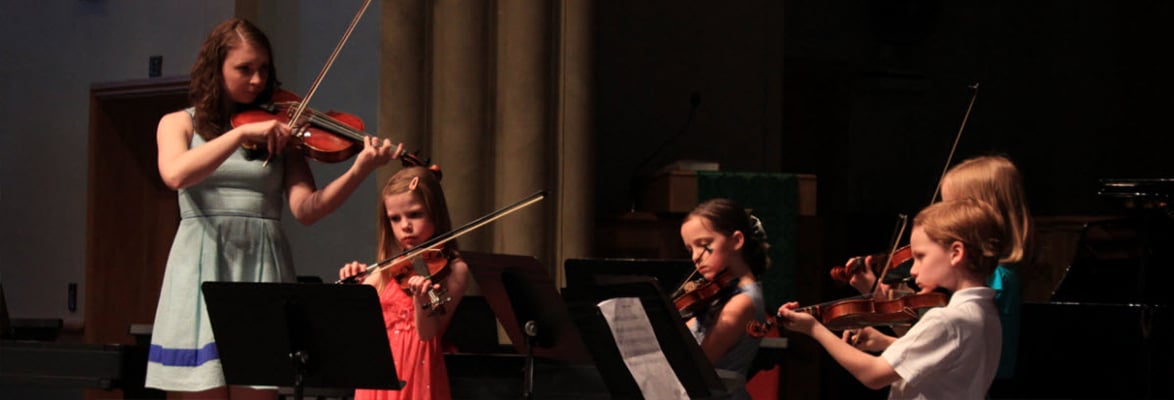by Laura Mason, Music Artistry Instructor with Kathy’s Music
A student’s repertoire, or pieces and exercises they are playing, can be considered their musical diet. We’ve discussed the importance of musical dessert, but a balanced diet also includes vitamin-rich foods which support growth and help the body stay healthy. I want to share three musical vitamins which are essential to the repertoire diet. These elements of musical study not only support growth as an instrumentalist or vocalist but provide a foundation to keep this development healthy.
Technique
To quote a Richard and Robert Sherman song, “Every truly cultured music student knows you must learn your scales and your arpeggios.” Whether it’s scales and arpeggios or etudes, technique exercises are an essential part of a student’s musical diet. Distilled down to its most basic definition technique is the “how” of playing – how to hold the bow when playing the violin, how to shape your mouth when playing the saxophone, how to use your breath when singing. But a focus on technique or “how” isn’t just for the beginning of a new musician’s journey.
Proper technique ensures the musician stays healthy. We often think of being a musician as a very intellectual and creative activity, but playing an instrument and singing are also very physical activities. As with all repeated physical activities we must constantly be checking that we are using the proper technique or our bodies will respond poorly. This is especially true for young singers whose “instrument” is growing along with them.
Honing technique is also directly related to producing good tone and a pleasant sound. A flutist can play all the correct notes at exactly the right time, but if the tone is lacking, then the full beauty of the piece is not achieved. Now don’t get me wrong, there will definitely be times along a student’s musical journey where the tone is less than ideal. I can still remember my grandma’s dog hiding the first time I played my trumpet for her. But with consistent attention to technique, tone improves and becomes something the student can manipulate easily.
When I was in highschool, I had a friend tell me they had stopped taking piano lessons because they had already learned everything. As an adult I can confidently say that I still have room for growth as pianist, and I don’t believe there will come a time when I have completely “mastered” my instrument. There are more pieces in the piano repertoire than I could get to in several lifetimes and each has its own technical challenges. All this to say that even after all the notes, rhythms, and musical symbols are learned, developing good technique continues and grows to meet new challenges. What started as a one-octave arpeggio to encourage a relaxed wrist and finger independence turns into a four octave arpeggio to develop a fluid wrist motion and consistent finger weight for “Fur Elise.”
Theory
If technique is the “how” of playing then theory is the “what.” It’s knowing what the notes, rhythms, and symbols are, but it is also knowing what makes a major scale a major scale or minor chord a minor chord. At the beginning of a musician’s journey, repertoire and theory are inseparable. The music presented is chosen or written to support and practice the theory concept introduced, whether that be middle C or playing piano and forte. As a student’s repertoire gets more difficult often times the theory lesson is derived from the piece, but it is no less essential. In order to use the arpeggio technique that has been developed one must be able to find the arpeggiated passages of a piece. It is much like the study of math. You can just use a formula because your teacher said so, but in order to tackle problems on your own you need to know why you are using that formula and what makes that formula work. This is why scales, arpeggios, and chords are so prominent in musical study; they are the joining of technique and theory. You are honing the “how” while reinforcing the “what” of music. These scales, arpeggios, and chords have been the building blocks of pieces for a long time, which brings me to my final musical vitamin.
Classics
In other words, what could be considered the staples of a musician’s repertoire, pieces by Bach, Mozart, and the list goes own. Why play these pieces besides the fact that they are beautiful in and of themselves?
Well, they have stood the test of time and as such are representative pieces of the era of music they came from. Each era has its own skill to teach. The polyphonic nature of the Baroque era of Bach is the ideal vehicle to work on advanced finger independence when playing the piano. The varied languages of the vocal repertoire allow for students to experience vowel sounds that don’t show up in English. With these new sounds become an increased awareness of how to adjust the vocal mechanism to create different resonances.
Music is not composed in a bubble. That is to say every composer has been influenced by previous composers. When we are learning staples of the musical repertoire we are not journeying around music — we are journeying through music. Each piece teaches a lesson that will make the next step easier, and seeing the connection between composers is both a useful and beautiful thing.
Before I finish I would like to quote another Sherman Brothers song, “A spoonful of sugar helps the medicine go down,” or in this case the vitamins. Technique and theory don’t need to feel like something you have to get through to get to the fun stuff. They can be a part of the fun stuff. So much of our experience depends on how we and the people around us frame it. I’ve personally had a lot of fun completing the scales and arpeggios of the circle of fifths with my students, and I will never get tired of the way their eyes light up when they discover a new piece of the puzzle.
Laura Mason is a Piano and Voice teacher with Kathy’s Music. She is a guest blogger for our school and also teaches Studio Singers, Kindermusik, and Musical Theatre Camp.


Leave a Reply